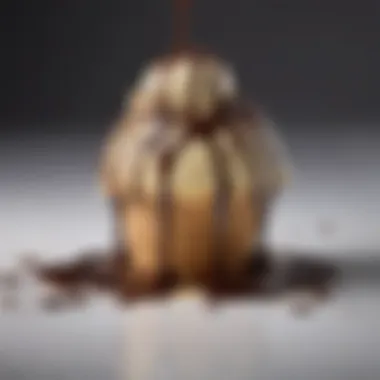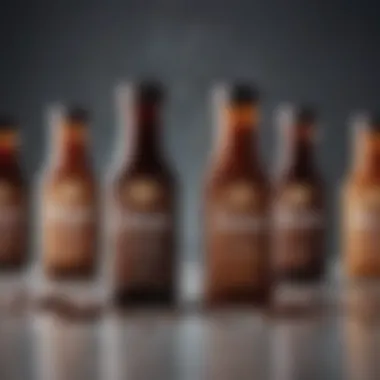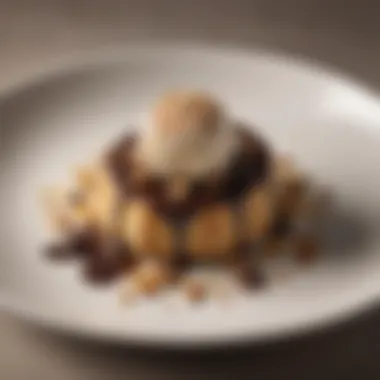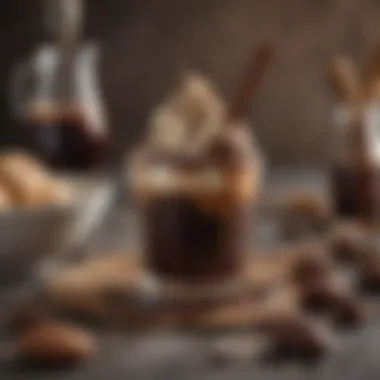Chocolate Syrup for Ice Cream: Elevate Your Dessert Experience


Intro
Chocolate syrup represents more than just a topping; it plays an integral role in the ice cream eating experience. Understanding the origins, diverse recipes, and pairings can greatly enhance one’s appreciation for this beloved dessert component. With busy lifestyles defining modern life, mastering chocolate syrup allows for delightful yet straightforward culinary fun.
Recipe Overview
Presenting your luscious dessert with a rich chocolate syrup elevates its allure. This section covers the essentials for creating chocolate syrup that will complement ice cream effectively.
- Name: Decadent Chocolate Syrup
- Portions: Makes about 1 cup
- Time Required: 15 minutes prep, no cook time
- Difficulty: Easy
- Main Ingredients:
- Unsweetened cocoa powder
- Water
- Granulated sugar
- Vanilla extract
- Salt
Step-by-Step Instructions
- Prep the Ingredients. Collect unsweetened cocoa powder, water, granulated sugar, vanilla extract, and a pinch of salt. Make sure you have measuring cups and spoons ready.
- Mix Dry Ingredients. In a saucepan, combine half a cup of unsweetened cocoa powder and one cup of granulated sugar. Stir them together for even distribution.
- Add Water. Gradually pour in half a cup of water. Use a whisk to mix the components thoroughly ensuring no lumps remain.
- Cook on Low Heat. Place the saucepan on low heat. Stir until the concoction begins to thicken, approximately 5 minutes.
- Finish the Syrup. Once the texture appears glossy, remove it from the heat and add one teaspoon of vanilla extract and a pinch of salt. Stir well to integrate the flavors.
- Let It Cool. Allow the syrup to cool before drizzling over ice cream. Store any leftovers in an airtight container in the refrigerator.
Time-Saving Strategies
Using a microwave-safe bowl, you can combine ingredients and heat them for about one minute intervals. Stir between each interval until fully mixed.
Substitutions and Alternatives
If you prefer not to use sugar, consider using agave syrup as a substitute which might offer a different yet enjoyable flavor profile.
Nutritional Information
One serving of this chocolate syrup, approximately two tablespoons, contains:
- Total Calories: 100
- Protein: 1g
- Fats: 0.5g
- Carbohydrates: 25g
Beneficial nutrients include:
- Antioxidants from cocoa powder
- Natural sweetness without synthetic additives
Quick Cooking Tips
- Utilize a blender for quick mixing if texture becomes too lumpy during preparation.
- While cooking in the saucepan, multitask by prepping ice cream scoops.
Healthier Alternatives
A lower sugar cocoa syrup recipe might employ alternatives like stevia. Explore different types of milk, such as almond milk, replacing water for added creaminess.
Related Recipes & Variations
- Chocolate Banana Sundae: Use your chocolate syrup over banana slices and add ice cream.
- Coffee-Infused Chocolate Syrup: For coffee lovers, consider adding espresso for a richer flavor.
- Vegan Chocolate Syrup: Using coconut sugar and almond milk can lead to a deliciously creamy recipe.
Share your versions of chocolate syrup and how you utilize it in creative desserts! Your input enriches this narrative and encourages culinary exploration.
Intro to Chocolate Syrup
Chocolate syrup serves as more than just a sweet addition to ice cream; it occupies a vital space in the realm of desserts and treats. It is a product that interlaces textures, enriches flavors, and bolsters cultural experiences around dessert consumption. By delving into chocolate syrup's essence, its historical framework, and its placement within dessert culture, one can appreciate better how it enhances the common dish of ice cream.
Historical Context of Chocolate Syrup
The journey of chocolate syrup dates back to the mid-19th century. By 1828, Dutch chemist Coenraad Johannes van Houten developed a process to extract cocoa butter from cocoa beans, leading to the formulation of cocoa powder. This marked a significant step toward the accessibility of chocolate. While syrups were in use, it was not until the late 19th century that chocolate syrup akin to what we know today emerged. Popular brands began to pioneer its sweetness, crafting a familiar blend enjoyed in households across various cultures.
The Role of Chocolate Syrup in Dessert Culture
Chocolate syrup is more than a topping; it is a transformative element within dessert culture. When assessing its social implications, it plays diverse roles.


- Culinary Creativity: It allows both professional chefs and home cooks to explore vast creativity in layering flavors and altering taste experiences.
- Comfort and Indulgence: Serving as a nostalgic reminder of childhood, chocolate syrup elicits comfort and joy. Its association with simple pleasures builds strong connections between individuals and their memories.
Culinarily, chocolate syrup completes numerous iconic desserts besides ice cream—think chocolate milk, sundaes, and pastries—further underlining its significance. Additionally, the syrup has established its identity in popular culture through advertising and representation in films and shows, demonstrating its lasting legacy as a beloved dessert staple.
Ingredients of Chocolate Syrup
Understanding the ingredients of chocolate syrup is crucial, as they directly affect the flavor, texture, and overall quality of the syrup. Each component plays a special role, and the right combination can determine whether the syrup elevates a simple scoop of ice cream or falls flat. Quality ingredients enhance the dessert experience, providing balance and depth in flavor that makes each bite enjoyable.
Key Ingredients Explained
The primary components of chocolate syrup typically include:
- Cocoa Powder: This forms the base of most chocolate syrups. The flavor intensity is directly linked to its quality. Using premium cocoa brings richness and depth.
- Sugar: Needed for sweetness, sugar balances the cocoa's bitterness. Different sugars can also impart diverse tastes; for instance, brown sugar provides a hint of molasses.
- Water: This ingredient helps to dissolve the sugar and cocoa, creating a syrupy consistency. Adjusting the water amount changes th consistency, affecting both taste and application.
- Corn Syrup: Often added to prevent crystallization, this ingredient is essential for a smooth texture.
Additionally, some recipes might include salt and vanilla extract to enhance flavor. These ingredients work together to create a harmonious syrup. Of course, variations may exist. Many home cooks prefer dark cocoa for a bolder flavor, while others may opt for semi-sweet variants, leading to varying applications in desserts.
Variations in Ingredient Quality
The quality of ingredients can vary significantly among brands and home cooking. For instance:
- Cocoa Powder: Gourmet brands often offer single-origin cocoa, known for specific flavor profiles. In contrast, lower quality powders may provide a more generic chocolate flavor, which rarely satisfies culinary enthusiasts.
- Sugar Types: Not just granulated; using organic or specialty sugars adds depth. Coconut sugar and other alternatives can alter flavor nuances in interesting ways.
- Additives: Some brands add preservatives or artificial ingredients, which can negatively impact taste and health factors. Home-made varieties use pure ingredients, leading to purer flavors.
Choosing quality ingredients is key in recipe development. Consideration towards ingredient sourcing ensures a delicious product, that not only boasts superior taste but also appeals to health-conscious consumers. Thus, understanding these ingredient components and variations enables a more enjoyable experience.
Choosing quality ingredients elevates the scoop of ice cream it accompanies.
Homemade Chocolate Syrup Recipe
Creating a homemade chocolate syrup is not just a fun alternative to store-bought options, but it also allows for a tailored approach to flavors and sweetness. The method of making chocolate syrup at home encompasses simple ingredients, and it gives consumers control over the final product. This is essential for those who are health-conscious or prefer specific profiles. With homemade chocolate syrup, all ingredients can be selected, qualifying it as a versatile and healthier option.
Preparation Steps
Making your own chocolate syrup is straightforward. Here’s a simple recipe to get you started:
Ingredients:
- 1 cup of sugar
- 1 cup of water
- 1 cup of unsweetened cocoa powder
- 1 teaspoon of vanilla extract
- A pinch of salt
Instructions:
- Begin by combining sugar, water, and cocoa powder in a saucepan.
- Heat the mixture over medium heat, stirring frequently until the sugar dissolves and starts to boil.
- Lower the heat and let it simmer for about 2 to 3 minutes. Stir the mixture occasionally.
- Remove the pan from heat. Add the vanilla extract and salt, stirring until well incorporated.
- Allow it to cool before transferring into a container.
- Store in the refrigerator for later use.
Homemade chocolate syrup can also be customized by adding more or less cocoa powder, sugar, or even a hint of espresso for depth.
Tips for Achieving the Perfect Consistency
Consistency is vital in chocolate syrup to ensure that it adheres well to ice cream or other desserts. Consider the following tips:
- Use the correct measurements: Precision in measurements goes a long way in creating a smooth consistency.
- Simmer adequately: A proper simmer allows water to reduce and leads to a thicker syrup. Keep an eye on it to avoid burning.
- Check for thickness: Allow the syrup to cool, as it may thicken further as it reaches room temperature.
Stirring continuously while heating can also help achieve a velvety texture without lumps.
Common Mistakes and How to Avoid Them
When preparing chocolate syrup, there are common pitfalls one might encounter:
- Burning the sugar: Constant stirring prevents sugar from settling and burning. Cooking it on a lower heat can avoid this disaster.
- عدم استخدامenzierungquality ingredients: Using low-quality cocoa powder will affect overall taste. Opt for a naval brand to enhance the flavor.
- Not storing properly: Ensure that it cools completely before placing it in the fridge. Sealing it too soon can lead to condensation and dilute the syrup.
Remember: The secret to a flawless chocolate syrup lies in attention to detail—every step impacts the final taste and texture.
Store-Bought Chocolate Syrup Analysis


Store-bought chocolate syrup is more than just a convenience item; it's a vital part of the modern dessert experience. Many people are pressed for time and often seek quick options for toppings that can enhance their desserts without extensive efforts in the kitchen. Understanding your choices in store-bought chocolate syrup can help you make informed decisions based on taste, quality, and health considerations.
Evaluating Popular Brands
There is a wide array of chocolate syrup brands available on the market. Each brand presents unique flavors and formulations, often emphasizing different qualities. Common names include Hershey's, Smucker's, and Ghirardelli. When evaluating these brands, consider the following aspects:
- Flavor Profile: Taste varies significantly. Different brands utilize distinct types of cocoa and sweeteners, leading to a range of flavors.
- Texture: A syrup must complement ice cream. Some products are more viscous, while others have a thin consistency which can affect how they distribute on ice cream.
- Ingredient Quality: Higher-quality ingredients generally yield better tasting syrup. Brands like Ghirardelli are known for using premium cocoa, while others might contain fillers or artificial flavors.
Consumer reviews also play a crucial role. Resources like Reddit and consumer forums provide insights into preferences, from flavor to potential aftertaste issues.
Understanding Labels and Ingredients
Reading labels is essential in the decision-making process. Often the first ingredient tells a lot about the product.
- Sugar: Many chocolate syrups have sugar listed at the top, indicating a sweeter flavor.
- Cocoa: Check the type of cocoa used. Natural cocoa offers diverse flavors compared to Dutch-processed versions.
- Additives: Some syrups may have preservatives or thickeners. It is critical to assess whether such additions suit your eating habits.
When comparing the labels, pay attention to serving size, caloric content, and additional nutrients. The nutritional breadth of store-bought chocolate syrup can significantly influence your dietary choices, especially for health-conscious consumers.
Important Note: The selected product can shift based on dietary provided insights and personal preferences. The key is paying attention to price vs. quality ratio adjusted for individual needs.
Overall, a thoughtful analysis of store-bought chocolate syrup enhances both the enjoyment and satisfaction derived from your dessert choices.
Pairing Chocolate Syrup with Ice Cream
Pairing chocolate syrup with ice cream enhances the dessert experience by creating a delightful fusion of flavors and textures. Chocolate syrup, whether homemade or store-bought, serves as a rich complement to ice cream’s creaminess. Proper pairing is essential as it can elevate the taste, appealing to various preferences. Here, we will examine not only the sweetness of the chocolate syrup, but also how its flavors meld beautifully with specific ice cream varieties. Additionally, we will explore accompaniments that make the combination even more memorable.
Flavor Compatibility of Ice Cream Varieties
When selecting ice cream flavors to pair with chocolate syrup, it is vital to consider the harmonic qualities of both. Different ice creams provide distinct experiences. Here are a few examples:
- Vanilla: This classic pairing allows chocolate syrup to shine. The creamy vanilla sets the stage for the syrup’s rich tones.
- Mint Chocolate Chip: This combination offers a refreshing twist. The freshness of mint combined with chocolate flavors can be quite satisfying.
- Coffee: The bitterness in coffee ice cream can balance the sweetness of the syrup. A clearly differentiated experience emerges, with depth in each bite.
- Salted Caramel: The play between salt and sweetness can enhance both the chocolate syrup and the caramel flavors, creating a luxurious dessert.
Additionally, understanding the intensity of flavors can guide the pairing process. Dark chocolate syrup, for instance, works well with bold ice cream tastes like rum raisin, while a lighter syrup can pleasantly accompany fruity flavors, such as raspberry or strawberry.
Accompaniments that Enhance Chocolate Syrup
Accompaniments can significantly enhance the overall ice cream and chocolate syrup experience. While the syrup adds a layer of richness, other toppings provide texture and additional flavor profiles. Here are some suggestions:
- Nuts: Adding chopped walnuts, pecans, or hazelnuts can add crunch, keeping the balance of flavors in check. The nuttiness pairs well with both chocolate and cream.
- Fruits: Fresh fruit like bananas, strawberries, or cherries can provide a refreshing contrast to the heaviness of chocolate syrup. These not only add natural sweetness but also introduce acidity, enhancing the flavor complexity.
- Whipped Cream: A dollop of whipped cream can create an indulgent serving while lightening the feel of the dessert. However, the cream should be minimally sweetened to maintain flavor balance.
- Sprinkles or Crushed Cookies: These additions offer a playful touch. They not only create visual appeal but also contribute texture that complements the syrup overtone.
Pro Tip: Always consider balancing sweetness. If your chocolate syrup leans heavily on the additive sweet side, it might be useful to choose darker, less sweet ice cream or a combination of fresh toppings that introduce tartness or bitterness.
With these considerations in mind, the art of pairing chocolate syrup with ice cream becomes a thoughtful culinary endeavor. Each choice contributes to the overall enjoyment, creating opportunities for exploration and delighting your palate.
The Nutritional Aspect of Chocolate Syrup
Understanding the nutritional aspect of chocolate syrup is essential. Many consider chocolate syrup to be simply a indulgent topping for ice cream, but it can actually have several noteworthy features. This section will dissect the caloric content and potential health benefits associated with chocolate syrup, providing a well-rounded view to consumers who may overlook this detail in their dessert choices.
Caloric Considerations
Chocolate syrup, like many sweet toppings, is typically high in calories. A standard serving, which is about two tablespoons, can contain approximately 100 to 150 calories, depending on the brand and specific ingredients. This high caloric density is often derived from sugar, which is usually the primary ingredient.
When trying to manage calorie intake, portion control is vital. Using smaller amounts can still offer satisfying flavor without overwhelming one's daily caloric needs. Considerations like using chocolate syrup sparingly or pairing it with healthier ice cream options, such as those classified as low-fat or dairy-free, can help maintain balance.
It's important to be mindful. Noting the caloric content on product labels allows consumers to keep track. Recognizing how chocolate syrup fits into one's larger meal plan is essential for anyone looking to eat mindfully.
Potential Health Benefits
Surprisingly, chocolate syrup may offer some potential health benefits if made with quality ingredients. When incorporating cocoa into chocolate syrup, it brings several advantages.
- Antioxidants: Cocoa contains flavonoids, which can have antioxidant properties. These might help reduce inflammation and lower blood pressure.
- Mineral Content: Cocoa is rich in magnesium, iron, and manganese. These minerals are important for various bodily functions, contributing positively to overall health.
- Mood Enhancement: The components in cocoa are also known to stimulate the production of endorphins, possibly enhancing mood.


However, it’s vital to remember that potential benefits can excel when syrups are homemade or chosen from select brands with minimal additives.
Storage and Shelf Life of Chocolate Syrup
The storage and shelf life of chocolate syrup are crucial to maintaining its quality and flavor. Ice cream toppings like chocolate syrup can be easily subject to changes in texture and taste if not stored properly. With the right techniques, individuals can enjoy chocolate syrup’s rich flavor for a long time, making it an essential consideration for anyone who frequently indulges in desserts. Understanding proper storage methods ensures that your chocolate syrup remains fresh and delicious, allowing for an optimal experience when paired with ice cream.
Proper Storage Techniques
To preserve both flavor and quality of chocolate syrup, consider some proper storage techniques:
- Air-Tight Containers: Use containers with airtight seals. These minimize air exposure, helping to prevent the syrup from thickening.
- Temperature Control: Store it in a cool, dry place away from direct sunlight. A pantry shelf is an ideal location.
- Refrigeration: While chocolate syrup can often be stored at room temperature, refrigeration can further extend its shelf life. If refrigeration is chosen, ensure it's in an airtight container to minimize moisture absorption.
- Avoid Cross-Contamination: Always use clean utensils when dispensing syrup. Nasty bacteria can enter the container if dirty utensils are used.
These techniques not only enhance the shelf life but also maintain the syrup's consistent flavor. Properly stored chocolate syrup can last several months without a decline in taste or texture.
Signs of Spoilage
Despite your best efforts in storage, occasionally, chocolate syrup might spoil. Here are some key signs to look out for:
- Changes in Texture: If you notice an unusually thick or clumpy texture, the syrup may be spoiled.
- Off Smell: A sour or rancid odor is usually an indicator of spoilage.
- Color Changes: Discoloration or a cloudy appearance can suggest that the syrup has gone bad.
- Mold Presence: Any traces of mold indicate that it's no longer safe to consume.
It's essential to periodically check your chocolate syrup for these signs, particularly before using it as a topping.
By adhering to these guidelines regarding storage and watchers for spoilage, one can ensure that your chocolate syrup remains an enjoyable addition to your ice cream and desserts for a long time.
Cultural Significance of Chocolate Syrup
Chocolate syrup is not merely a topping; it holds a deeper cultural significance across various societies. Its presence in desserts shapes both individual and collective experiences. The versatility and adaptability of chocolate syrup reflect local tastes and traditions, providing a medium through which connections can be forged. The following sections will delve into the regional variations in its usage as well as its portrayal in popular media, highlighting the role of this simple ingredient in diverse cultural contexts.
Regional Variations in Usage
Different cultures incorporate chocolate syrup in unique ways, reflecting their preferences and culinary traditions. In the United States, chocolate syrup-Often used as a quintessential ice-cream topping, is favored for its sweet and rich flavor. In Europe, however, it might appear as a drizzle on pastries or cakes rather than ice cream. The texture, consistency, and flavor profile are often adapted to suite local tastes.
In Latin America, sauces made from chocolate, sometimes known as molten ganache, often combine with ice cream and other desserts, creating indulgent experiences. Here, the richness and depth of chocolate are highly valued, reflecting cultural appreciation for sweetness. These variations showcase how chocolate syrup evolves according to context, demonstrating its global influence in the culinary landscape.
Chocolate Syrup in Popular Media
Chocolate syrup appears frequently- in popular media representations. Whether in commercials, movies, or television shows, this beloved topping holds a symbolic meaning. For example, in children's programming and kids sold commercial products, it evokes feelings of joy, nostalgia, and indulgence.
From Suzanne Collins' The Hunger Games, where characters mention chocolate syrup to describe indulgence, to iconic film scenes where desserts look exceptionally tempting with chocolate drizzle, the portrayal is consistent. It symbolizes comfort and enjoyment and is often associated with celebrations or special occasions.
In rhythm and media, programs often highlight ease and quick use of chocolate syrup in homemade desserts, framing it as a simple but impactful choice. Memorable lines or scenes revolving around chocolate syrup can spark interest among culinary enthusiasts, leading them to rethink or innovate their approaches to desserts. These representations solidify chocolate syrup's role as integral to collective dessert culture, marking it both delicious and culturally relevant.
Culmination
Gainfully, the insights provided reveal that thoughtful selection and preparation of chocolate syrup can transform an ordinary dessert into something remarkable. Pay attention to ingredient quality. Homemade varieties can disrupt store-bought consistency in positive ways.
Following this guide, individuals can make informed decisions, whether opting for homemade options or selecting from diverse available brands. Additionally, understanding caloric impacts and potential health benefits will encourage moderation.
"Chocolate syrup enriches not just flavor, but the culture around dessert itself."
Ultimately, this comprehensive exploration encourages personalization of dessert presentations by pairing various ice cream flavors with unique toppings or accompaniments to create a harmonized experience. As we close, let us reflect on these interpretations and applications to fully enjoy chocolate syrup within our culinary adventures.
Recap of Key Insights
Throughout this article, many vital points have emerged around chocolate syrup. First, its rich history shows how it has evolved in dessert culture. We learned about primary ingredients and the variations in quality, emphasizing the impact that this has on flavor. A detailed recipe provided practical steps for creation, while tips for consistency address common errors in the homemade process.
The evaluation of popular brands aids consumers in making informed purchases. Furthermore, identifying supportive companions for syrup harmonizes flavor experiences. Nutritional aspects cannot be overlooked as well. Understanding caloric impact and health facets equips readers to enjoy desserts mindfully.
Typically, one would consider pairing chocolate syrup with desserts, focusing narrowly on ice cream. However, numerous options exist outside that framework and radically expand that culinary horizon. The cultural significance invited greater appreciation in a global context, exposing regional variations in usage.
Encouragement to Explore and Experiment
After absorbing the insights provided, readers should feel empowered to explore the fluidity of chocolate syrup usage. Delve into personal creativity. It invites exploration, allowing for flexible concoction of flavors, or even experimentation with unusual combinations. Trying unique syrups from around the world can unveil delightful experiences and scintillating contrasts in flavors.
Home-cooks are especially urged to tweak recipes, blend different syrups, or pair them with novel ice cream varieties. This experimentation is filled with potential as each dessert can tell its own story through charm of ingredients and the unique palate perspectives.
Ultimately, innovation should be encouraged in culinary pursuits. Don’t hesitate to redefine what chocolate syrup represents for you. Seek out ways to celebrate its potential leverage—whether through traditional presentations or by creating avant-garde mixtures. Essentials like these turning into inspirations is precisely what leads to a greater appreciation of desserts as a whole.







